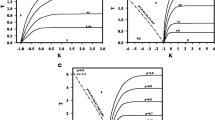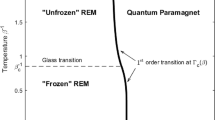Abstract
A new integrable long-range model is derived from a new asymmetric R-matrix recently discussed by Bibikov in relation to a XXZ spin chain in an external magnetic field. The algebraic Bethe Ansatz is used to derive the eigenvalues and equations for the eigen momenta both for the usual and long-range model.
Similar content being viewed by others
REFERENCES
Albertini, G., Dahmen, S. R., and Wehefritz, B.(1996). Phase diagram of the non-Hermitian asymmetric XXZ spin chain. Journal of Physics A: Mathematical and General 29, L369.
Bibikov, P. N. (2000). Solv-int/0011035. R-matrix forasymmetrical XXZ spin chain in magnetic field.
Choudhury, A. G. and Chowdhury, A. R. (1996). On a long rangevariant of the discrete NLS equation and algebraic Bethe ansatz. Physica Scripta 53, 129.
de Vega, H. J. (1984). Families of commuting transfer matrices andintegrable models with disorder. Nuclear Physics B 240 [FS 12], 495.
Hikami, K., Kulish, P. P., and Wadati, M. (1992). Integrable spinsystems with long-range interactions. Chaos, Soliton and Fractals 2, 543.
Korepin, V. E., Izergin, A. G., and Bogoliubov, N. M. (1993).Quantum Inverse Scattering Method and Corelation Functions, Cambridge University Press, Cambridge, UK.
Author information
Authors and Affiliations
Rights and permissions
About this article
Cite this article
Choudhury, A.G., Chowdhury, A.R. A New Asymmetric Long-Range Model and Algebraic Bethe Ansatz. International Journal of Theoretical Physics 41, 321–330 (2002). https://doi.org/10.1023/A:1014015124456
Issue Date:
DOI: https://doi.org/10.1023/A:1014015124456




